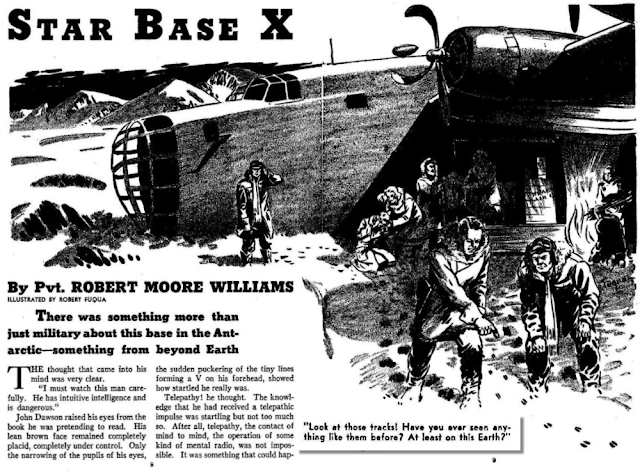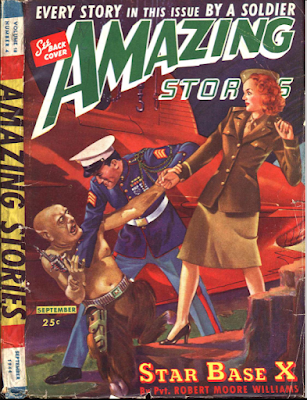Raymond A. Palmer was the editor of science fiction magazine Amazing Stories, and it can be said he was in the UFO business well before the first flying saucer was seen. He became infamous for publishing Richard Shaver’s pre-saucer tales of ancient aliens living beneath the earth as nonfiction, "The Shaver Mystery" starting in 1945. However, even before that, he promoted the Charles Fort-derived notion of extraterrestrial spaceships visiting earth as reality. Below are two UFO-like stories set during World War II that Palmer presented three years before the coming of the saucers.
Intruders from the Stars
Amazing Stories Jan. 1944, presented a
pulpy space romance that’s included here due to the depiction of the threat of
the extraterrestrial spaceship’s superior technological performance.
The next story is far closer to flying saucer lore, but also plays on the military theme.
Star Base X
Amazing Stories Sept. 1944, had a patriotic gimmick: “Every story in this issue by a soldier.” Ray Palmer said in this editorial, “Pvt. Robert Moore Williams is in the air force, but has just come from 99 days in camp hospital with pneumonia. There's a guy with guts! His manuscript came in just the same!” Robert Moore Williams' story was the cover feature, “Star Base X.”
Searching for the escaped spy, the group of soldiers discover a secret underground base in a cave carved out of hill which contains a hangar for a huge glittering teardrop-shaped space ship (which they later learn is outfitted with advanced weapons and technology).
There are eight aliens inside, Aherned, hooved goat-like humanoids, described as looking like “Pan without the horns... no bigger than a boy of twelve.” They also have telepathy and hypnotic mental powers., which is how their agent Eldron had impersonated a crewman. The aliens abduct the meddling humans and hold them in an imaginary cage projected by their minds. We learn that the aliens use Earth as a base to facilitate their communication and travel between stars. The engineer Carson offers to work with the aliens in return for their technology, “We would welcome you, help you, provide you with supplies... I don't mind telling you how much a ship like that would mean to the human race.”
There are eight aliens inside, Aherned, hooved goat-like humanoids, described as looking like “Pan without the horns... no bigger than a boy of twelve.” They also have telepathy and hypnotic mental powers., which is how their agent Eldron had impersonated a crewman. The aliens abduct the meddling humans and hold them in an imaginary cage projected by their minds. We learn that the aliens use Earth as a base to facilitate their communication and travel between stars. The engineer Carson offers to work with the aliens in return for their technology, “We would welcome you, help you, provide you with supplies... I don't mind telling you how much a ship like that would mean to the human race.”
The aliens reject the suggestion of such a treaty, and Eldron says their existence must remain secret, as they are sure man would eventually use space ships for war against them. The Aherned intend to kill the humans to silence them, but before their mental powers can subdue them all, one pulls a pistol and shoots Eldron. This starts a firefight with the aliens, who return fire with their laser-like beam weapons, killing one man by burning a hole in his heart. The resistance takes the aliens by surprise, and they are forced to evacuate, taking flight in their spaceship.
As the Aherned ship departs, Carson thinks he can reverse engineer the aliens’ technology. “There are tools in that hangar, spare parts, enough equipment to… find out how that ship worked.” Unfortunately, the aliens bomb the hangar, leaving only charred wreckage. Later, a search team rescues the survivors, but Carson is still determined, and says, “Some day I’ll know how that thing operated. We’ll be building ships like that someday, now that we know they can be built.”
Fiction or Prophecy?
Ray Palmer is said to have believed the reason flying saucers were here was, “to make us think.” Part of our thought should focus on how science fiction influenced our beliefs about aliens and UFOs.








That's not the only case of pulp fiction finding it's way into UFO Lore. There is an entry from 2012 on the Bad Archaeology blog covering a case where the author of a 1960s Ancient Astronauts book called 'Not Of This World' reworked a story from pulp magazine adventure into 'evidence' for the reality of Ancient Astronauts. That blog entry is linked below.
ReplyDeletehttps://badarchaeology.wordpress.com/2012/11/10/does-fiction-become-true-if-its-repeated-often-enough-the-alien-of-tuerin-monastery/
When Jason Colavito was looking at the same book he spotted something similar, while he could not identify the specific story I suspect it may originate with pulp SF author Edmond Hamilton, although the book credits the tale to 'H. J. Hamilton'. That post is linked below this paragraph.
https://www.jasoncolavito.com/blog/review-of-peter-kolosimos-not-of-this-world-pt-1
It's interesting to see the relationship between science fiction and UFOs, particularly those concepts that appeared far in advance of 1947. It seems few things from saucer lore had not already been imagined by the human mind.
Delete